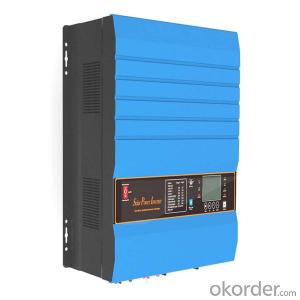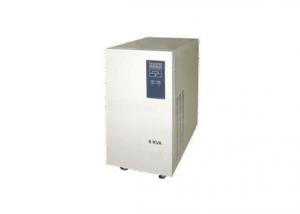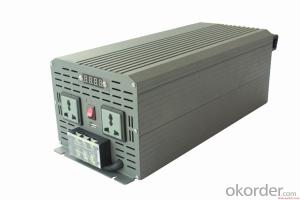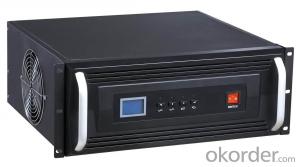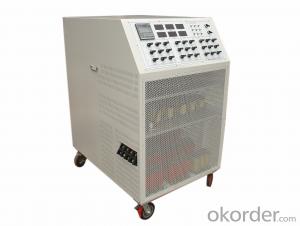10KW Pure Sine Wave Inverter New Function PV3500 Series 48V
- Loading Port:
- China main port
- Payment Terms:
- TT or LC
- Min Order Qty:
- 50 pc
- Supply Capability:
- 10000 pc/month
OKorder Service Pledge
OKorder Financial Service
You Might Also Like
Advances of Solar Inverter 10KW Pure Sine Wave Inverter New Function PV3500 Series 48V
Our solar inverters typically transfer to battery power in less than 16 milliseconds (less than 1/50th of a second).
Our solar backup electric systems use special high-quality electric storage batteries.
Main Features of Solar Inverter 10KW Pure Sine Wave Inverter New Function PV3500 Series 48V
.Power range 1kw-112kw
.12/24v/48v input optional
.Powerful Charge Rate Up to 100Amp
.Inbuilt pure copper transformer
.Pure sine wave output
.LED+LCD display
.MPPT solar charge controller 40A 45A 60A
.50/60HZ automatic sensing
.RS232 with free CD
.Battery priority function
.DC Start & Automatic Self-Diagnostic Function
.High Efficiency Design & “Power Saving Mode” to Conserve Energy
Specificationsc of Solar Inverter 10KW Pure Sine Wave Inverter New Function PV3500 Series 48V
Solar Inverter Model | 1.0KW | 1.5KW | 2.0KW | 3.0KW | 4.0KW | 5.0KW | 6.0KW | 8.0KW | 10.0KW | 12.0KW | |
Inverter output | Continuous output power | 1.0KW | 1.5KW | 2.0KW | 3.0KW | 4.0KW | 5.0KW | 6.0KW | 8.0KW | 10.0KW | 12.0KW |
Surge rating (20ms) | 3.0KW | 4.5KW | 6.0KW | 9.0KW | 12.0KW | 15.0KW | 18.0KW | 24.0KW | 30.0KW | 36.0KW | |
Output waveform | Pure sine wave/ same as input (bypass mode) | ||||||||||
Nominal efficiency | >88% (peak) | ||||||||||
Line mode efficiency | >95% | ||||||||||
Power factor | 0.9-1.0 | ||||||||||
Nominal output voltage RMS | 100-110-120VAC/220-230-240VAC | ||||||||||
Output voltage regulation | ±10% RMS | ||||||||||
Output frequency | 50Hz ± 0.3Hz / 60Hz ± 0.3Hz | ||||||||||
Short circuit protection | Yes (1sec after fault) | ||||||||||
Typical transfer time | 10ms (max) | ||||||||||
THD | < 10% | ||||||||||
DC input | Nominal input voltage | 12.0VDC / 24.0VDC / 48.0VDC | 24.0VDC /48.0VDC | 48.0VDC | |||||||
Minimum start voltage | 10.0VDC /10.5VDC for12VDC mode | *2 for 24VDC, *4 for 48VDC | |||||||||
Low battery alarm | 10.5VDC /11.0VDC for12VDC mode | ||||||||||
Low battery trip | 10.0VDC /10.5VDC for12VDC mode | ||||||||||
High voltage alarm | 16.0VDC for12VDC mode | ||||||||||
Low battery voltage recover | 15.5VDC for12VDC mode | ||||||||||
Idle consumption-search mode | <25W when power saver on. (refer to table) | ||||||||||
Charger | Output voltage | Depends on battery type (refer to table 2.5.2) | |||||||||
Charger breaker rating | 10A | 15A | 20A | 20A | 20A | 30A | 30A | 40A | 40A | 40A | |
Max charge power rate | 1/3 Rating power (refer to table 2.5.3) | ||||||||||
Battery initial voltage for start | 10-15.7VDC for 12VDC mode | *2 for 24VDC, *4 for 48VDC | |||||||||
Over charge protection S.D. | 15.7VDC for 12VDC mode | ||||||||||
BTS | Battery temperature sensor (optional) | Yes (refer to the table) Variances in charging voltage & S.D. voltage base on the battery temperature. | |||||||||
Bypass & protection | Input voltage waveform | Sine wave (grid or generator) | |||||||||
Nominal voltage | 110VAC | 120VAC | 220VAC | 230VAC | 230VAC | ||||||
Max input AC voltage | 150VAC for 120VAC LV mode; 300VAC for 230VAC HV mode. | ||||||||||
Nominal input frequency | 50Hz or 60Hz | ||||||||||
Low freq trip | 47 ± 0.3Hz for 50Hz; 57 ± 0.3Hz for 60Hz | ||||||||||
High freq trip | 55 ± 0.3Hz for 50Hz; 65 ± 0.3Hz for 60Hz | ||||||||||
Overload protection (SMPS load) | Circuit breaker | ||||||||||
Output short circuit protection | Circuit breaker | ||||||||||
Bypass breaker rating | 10 | 15 | 20 | 30 | 40 | 40 | 40 | 50 | 63 | 63 | |
Transfer switch rating | 30Amp for UL & TUV | 40Amp for UL | 80Amp for UL | ||||||||
Bypass without battery connected | Yes (optional) | ||||||||||
Max bypass current | 30Amp | 40Amp | 80Amp | ||||||||
Solar charger | Rated voltage | 12.0VDC / 24.0VDC / 48.0VDC | |||||||||
Solar input voltage range | 15-30VDC / 30-55VDC / 55-100VDC | ||||||||||
Rated charge current | 40-60A | ||||||||||
Rated output current | 15A | ||||||||||
Self consumption | <10mA | ||||||||||
Bulk charge (default) | 14.5VDC for12VDC mode | *2 for 24VDC, *4 for 48VDC | |||||||||
Floating charge (default) | 13.5VDC for12VDC mode | ||||||||||
Equalization charge (default) | 14.0VDC for12VDC mode | ||||||||||
Over charge disconnection | 14.8VDC for12VDC mode | ||||||||||
Over charge recovery | 13.6VDC for12VDC mode | ||||||||||
Over discharge disconnection | 10.8VDC for12VDC mode | ||||||||||
Over discharge reconnection | 12.3VDC for12VDC mode | ||||||||||
Temperature compensation | -13.2mVDC/℃ for12VDC mode | ||||||||||
Ambient temperature | 0-40℃ (full load) 40-60℃ (derating) | ||||||||||
Mechanical specifications | Mounting | Wall mount | |||||||||
Inverter dimensions (L*W*H) | 388*415*200mm | 488*415*200mm | 588*415*200mm | ||||||||
Inverter weight (solar chg) KG | 21+2.5 | 22+2.5 | 23+2.5 | 27+2.5 | 38+2.5 | 48+2.5 | 49+2.5 | 60+2.5 | 66+2.5 | 70+2.5 | |
Shipping dimensions (L*W*H) | 550*520*310mm | 650*520*310mm | 750+520+310mm | ||||||||
Shipping weight (solar chg) KG | 23+2.5 | 24+2.5 | 25+2.5 | 29+2.5 | 40+2.5 | 50+2.5 | 51+2.5 | 62+2.5 | 68+2.5 | 72+2.5 | |
Display | LED+LCD | ||||||||||
Standard warranty | 1 year | ||||||||||
Pictures of Solar Inverter 10KW Pure Sine Wave Inverter New Function PV3500 Series 48V
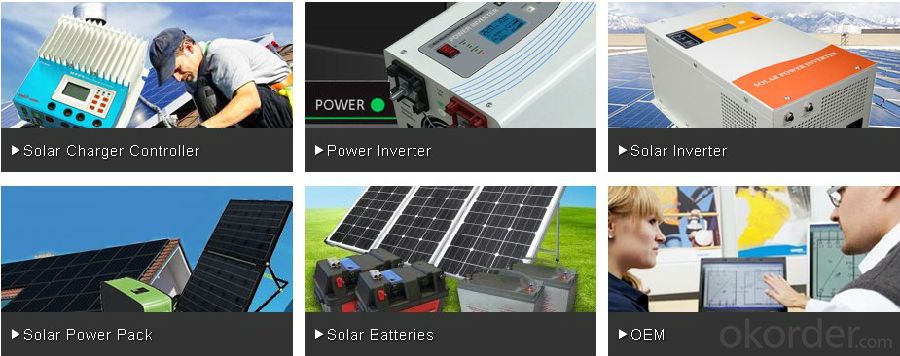
Solar Inverter's Application
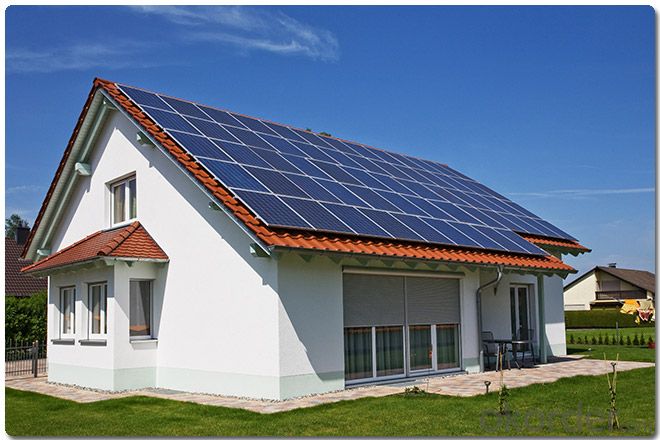
Warranty of Solar Inverter 10KW Pure Sine Wave Inverter New Function PV3500 Series 48V
OKorder’s Products provides a 1~3 year limited warranty (“Warranty”) against defects in materials and workmanship for its Uninterruptible power supply, Power inverter/chargers, Solar charge controllers, Battery Products (“Product”).
The term of this Warranty begins on the Product(s) initial purchase date, or the date of receipt of the Product(s) by the end user, whichever is later.
This must be indicated on the invoice, bill of sale, and/or warranty registration card submitted to MUST-Solar.
This Warranty applies to the original MUST-Solar Product purchaser, and is transferable only if the Product remains installed in the original use location.
Certificates of Solar Inverter 10KW Pure Sine Wave Inverter New Function PV3500 Series 48V
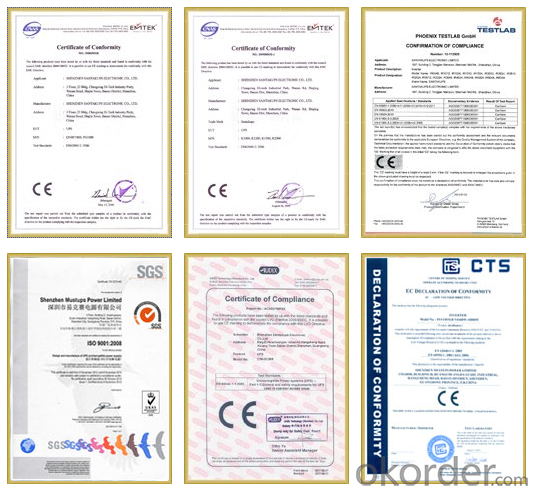
FAQ of Solar Inverter 10KW Pure Sine Wave Inverter New Function PV3500 Series 48V
How to guarantee the quality of the products?
We have established the international advanced quality management system,every link from raw material to final product we have strict quality test;
We resolutely put an end to unqualified products flowing into the market.
At the same time, we will provide necessary follow-up service assurance.
How long can we receive the product after purchase?
In the purchase of product within three working days, We will arrange the factory delivery as soon as possible.
- Q: How does a solar inverter protect against lightning strikes?
- A solar inverter typically protects against lightning strikes by incorporating surge protection devices and grounding systems. These features help to divert the excess energy caused by a lightning strike away from the sensitive electronic components of the inverter, preventing damage and potential electrical hazards.
- Q: What is the role of a solar inverter in a community solar project?
- The role of a solar inverter in a community solar project is to convert the direct current (DC) electricity generated by the solar panels into alternating current (AC) electricity that can be used to power homes and businesses. It also ensures that the electricity is synchronized with the utility grid and optimizes the efficiency of the solar power system.
- Q: How does a solar inverter handle voltage transients?
- A solar inverter handles voltage transients by regulating and stabilizing the incoming DC voltage from the solar panels, and converting it into a steady AC voltage suitable for use in the electrical grid or for powering appliances. It uses various electronic components and control algorithms to monitor and adjust the voltage levels, ensuring that any sudden changes or fluctuations in the input voltage are smoothed out and the output remains consistent and within acceptable limits.
- Q: Can a solar inverter be used in regions with high altitude conditions?
- Yes, a solar inverter can be used in regions with high altitude conditions. However, it is important to consider certain factors such as temperature variations, reduced air density, and increased UV radiation at higher altitudes. In such cases, it may be necessary to choose a solar inverter specifically designed to handle these conditions and ensure proper functioning and efficiency of the system.
- Q: What is the role of a solar inverter in a grid-tied system?
- The role of a solar inverter in a grid-tied system is to convert the direct current (DC) electricity generated by the solar panels into alternating current (AC) electricity that can be used to power electrical appliances and be fed back into the utility grid. It also ensures the synchronization of the solar system with the grid and regulates the voltage and frequency of the electricity being produced.
- Q: Can a solar inverter be used with a solar-powered vehicle?
- Yes, a solar inverter can be used with a solar-powered vehicle. A solar inverter is responsible for converting the direct current (DC) produced by solar panels into alternating current (AC) that can be used to power various devices. In a solar-powered vehicle, the solar panels generate DC electricity, which can be connected to a solar inverter to convert it into AC power that can be used to charge the vehicle's battery or directly power electric components.
- Q: What is the maximum AC output current that a solar inverter can provide?
- The maximum AC output current that a solar inverter can provide depends on the specific model and capacity of the inverter. In general, it is determined by factors such as the maximum power rating and efficiency of the inverter, as well as the size and configuration of the solar photovoltaic (PV) system it is connected to.
- Q: Can a solar inverter be used with a three-phase electrical system?
- Yes, a solar inverter can be used with a three-phase electrical system. In fact, many commercial and industrial solar installations use three-phase inverters to convert the direct current (DC) power generated by solar panels into alternating current (AC) power that can be used by the electrical grid. This allows for efficient power conversion and distribution in three-phase systems, which are commonly used in larger electrical installations.
- Q: Can a solar inverter be used with a solar-powered data center?
- Yes, a solar inverter can be used with a solar-powered data center. A solar inverter is an essential component that converts the direct current (DC) produced by solar panels into alternating current (AC) that can be used to power electrical equipment, including data centers. By integrating a solar inverter into the solar power system of a data center, the generated solar energy can be efficiently used to run the center's operations, reducing reliance on grid electricity and promoting sustainability.
- Q: Can a solar inverter be used in areas with limited roof space or installation options?
- Yes, a solar inverter can be used in areas with limited roof space or installation options. Solar inverters are typically compact and can be installed in various locations, such as the ground, walls, or even inside the house. In addition, there are different types of solar inverters available, including microinverters and power optimizers, which allow for more flexibility in system design and installation. These options can help maximize the use of available space and provide more installation options for areas with limited roof space.
Send your message to us
10KW Pure Sine Wave Inverter New Function PV3500 Series 48V
- Loading Port:
- China main port
- Payment Terms:
- TT or LC
- Min Order Qty:
- 50 pc
- Supply Capability:
- 10000 pc/month
OKorder Service Pledge
OKorder Financial Service
Similar products
Hot products
Hot Searches
Related keywords
